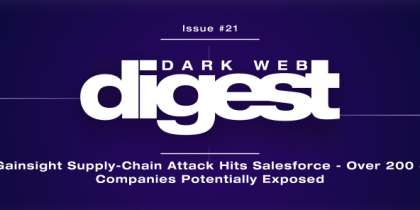Your email could be compromised.
Scan it on the dark web for free – no signup required.
Your Boarding Pass Just Became Hacker Bait…
You think of your frequent flyer number as something that upgrades your seat, not compromises your identity. Turns out, it’s fast becoming hacker bait.
Over 5 million Qantas customers have learned the hard way that metadata and personal records can sneak out from under your seat. This isn’t just a breach; they’ve been publicly exposed on the dark web. And it all started with a third-party link in the chain.
If your name, email, birthdate, or frequent flyer account is in the mix, this digest is your flight path to survival in the dark web skies.
What’s the News (in Short)
- Qantas confirms 5.7 million customer records have been stolen and released by cybercriminals.
- The data breach originated via a third-party contact-center platform, not a direct intrusion into Qantas’s core systems.
- Leaked fields include ~1 million exposed phone numbers, addresses, birthdate data; ~4 million records contain names + email details.
- Qantas insists financial info, passwords, passport data, and Frequent Flyer credentials were not compromised.
- Legal action is underway — Qantas secured an injunction from the NSW Supreme Court to block further use or publication of the stolen data.
- Since the incident, Qantas has bolstered security, tightened detection & training, and is coordinating with Australian government bodies.
- Dark Web Tip:👉 Run a free Dark Web Exposure Scan to see if your data is at risk.
What Happened — The Timeline & Scope
The breach dates back to a July 2025 incident involving a third-party platform, where the criminals used AI to trick a Manila-based Qantas call center into giving them access to the information. This attack is part of a growing wave of global cyberattacks targeting aviation, logistics, and travel sectors.
- Hacker collective Scattered LAPSUS$ Hunters claimed responsibility for leaked Qantas data. After a ransom deadline passed, the data dump appeared on dark web leak sites.
- The breach allegedly stemmed from Qantas’ Salesforce customer service platform, accessed via their call center operations. Attackers didn’t crack Qantas’ core systems — they impersonated IT/support to gain access.
What Was Leaked (or at Risk)?
Here’s what investigators and Qantas are confirming (and what is suspected):
- Exposed fields (confirmed/credible):
• Names, email addresses, phone numbers, dates of birth, and frequent flyer numbers.
• Home/physical addresses, gender, and meal preference data in some cases. - Not exposed (according to Qantas):
• Passwords, payment/credit card details, and passport numbers.
• Frequent Flyer account login credentials (Qantas says accounts remain secure). - Risk-amplifying metadata & proof leaks:
• Screenshots or sample data dumps are already showing up in leak forums, serving as proof-of-access.
• Metadata like internal customer IDs, call center logs, and service request runbooks may be embedded in the dumps — enabling more precise phishing and impersonation.
What Qantas Says
Qantas confirmed that it is one of several global companies impacted by the same threat actors. According to its October 12, 2025, update, the airline:
- Has an injunction in place via the NSW Supreme Court to prevent further use or sharing of the stolen data.
- Has notified all impacted customers earlier in July about the specific data types involved.
- Has added extra security layers, boosted staff cybersecurity training, and improved detection systems.
- Is working with Australian authorities, including the ACSC and AFP, while continuing to offer 24/7 identity protection services through a dedicated hotline.
Who’s Behind It
Scattered LAPSUS$ Hunters claimed the breach and published the stolen Qantas customer data after a ransom deadline lapsed. This group is tied to prior attacks on global brands and often uses social engineering, impersonation, supply-chain, and Salesforce hack vectors.
They often operate via proof leaks, sample dumps, and using the reputational advantage of “we have the files” to pressure victims.
Why This Leak Hits Hard — Dark Web & Threat Amplification
Airline databases are goldmines for criminals — offering not just identity data but behavioral patterns, travel frequencies, and even passport-linked information.
Once combined with other leaks, these datasets can enable:
- Phishing in hyperdrive: With emails, names, birth dates, and addresses in hand, attackers can craft ultra-convincing scam emails or SMS messages (“Qantas upgrade”, “booking confirmation”, “fraud check”).
- Metadata is now ammunition: Exposed service tickets, internal IDs, and call center logs provide phishers with the context to impersonate Qantas support with frightening authenticity.
- Proof leaks = validation: Publishing sample records or screenshots establishes credibility for criminals to extort more, sell complete sets, or reel in copycats.
- Resale & cross-referencing: Leaked Qantas data will be bundled with other leak datasets (Optus, Medibank, etc.), enabling broader credential stuffing, identity mapping, or account takeover attempts.
- Scam wave: “Second wave” already predicted: Reports warn of a surge in fraudulent calls, compensation scams, or “we can restore your data” offers to affected flyers.
- Legal & injunction limitations: Qantas secured a court injunction suppressing the use or publication of the data inside Australia, but once the data is on the dark web, geographical limitations don’t matter much.
What’s Happening on the Dark Web
Dark web forums are reportedly circulating snippets of Qantas-related data, including leaked passenger identifiers and contact lists tied to loyalty programs. While Qantas’ injunction may curb local access, the data’s presence online means fraudsters may still weaponize it internationally for phishing, travel-related scams, or identity misuse.
What You Should Do Right Now
- Run PureVPN’s Dark Web Exposure Scan — Protect exposed identifiers today. PureVPN offers a free scan (which is also linked above) that allows users to check if their credentials appear on the dark web marketplaces and forums. In ~30 seconds you’ll learn:
- Are you exposed?
- How severe is the compromise?
- How recent was the leak?
- How many breaches include your account?
- Change passwords & enforce MFA on all accounts tied to airline, travel, email, & loyalty systems.
- Be extremely cautious of phishing/impersonation attempts referencing Qantas — especially those using correct names, booking numbers, flight dates, etc.
- Verify all communications by calling Qantas via official numbers (not ones provided in suspicious emails).
- Monitor your identity — watch bank statements, tax returns, credit reports, and anomalies in loyalty accounts.
What’s Next
Qantas’s leak is a reminder that customer data is more than photos & profiles — names, birth dates, frequent flyer numbers, internal IDs are powerful weapons in a hacker’s arsenal. The dark web doesn’t wait; criminals will already be working combos, reusing leaked fields, launching scams, building dossiers.
If you flew Qantas or ever used their loyalty systems, assume your data might already be in someone’s research lab. Stay alert, scan your identity, and treat metadata like kryptonite — because that’s what hackers will try to use.
📬 Why Subscribe?
Every week, we cut through the noise and bring you the breaches that matter, the tactics behind them, and the steps you need to protect yourself — all in a conversational, no-fluff format.
If you don’t want to be the last to know when your personal data hits the dark web, subscribing is your safety net.
👉 Stay ahead, stay secure, stay subscribed.
Note: This edition of Dark Web Digest is based on publicly available information as of Oct 14th, 2025.








